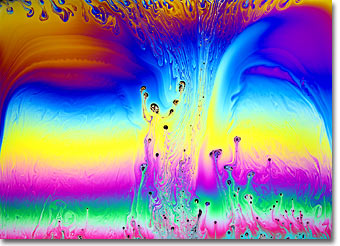Karl E. Deckart
Soap Bubble Gallery: Image Eight
German photographer and artist Karl E. Deckart is known for his thorough, precise, and beautiful work both in photography through the microscope and with macro camera systems. This gallery of interference photographs made with soap films is a testament to both Deckart's skill as a photographer and his understanding of the physical phenomena that surround our everyday lives. Presented below is soap bubble image number eight in small format. Click on the image to download a larger version.

|
Macrophotography of thin soap films freely suspended on a 4 x 4-inch wire frame was conducted with a Linhof large-format bellows camera system utilizing 4 x 5-inch sheet film and imaged using an apo-macro Nikon large format Nikkor-AM ED 210 mm f-5.6 lens. To prepare the soap film, equal parts of water, glycerin, and dishwasher detergent are thoroughly mixed in a container until a solution containing evenly sized micelles is achieved. A freestanding film is formed by dipping the wire frame into the solution and withdrawing carefully to maintain an even film thickness and avoid disruption of material flow across the frame rails. After suspension, the film was illuminated by a reflected light source positioned a few degrees from the camera system. The light was passed through a diffusion screen to avoid bright spots and provide an even illumination across the field. No polarizers were employed in photomacrography of soap thin films. Image ©1999 by Karl E. Deckart. All rights reserved. |
Soap in Colonial America was primarily used for laundering purposes and was usually made from pork fat and a crude form of lye. Dropping an egg into the solution to see if it sank or floated on top tested whether lye was strong enough. A rapidly sinking egg meant the solution was too weak. In order for the preparation to have the right consistency, an egg had to suspend or sink very slowly in the water and ash mixture. In the lower half of the Western Hemisphere, Aztec Indians were believed to have burned the fibers of certain medicinal native plants to obtain ash used in forming a type of soap for cleansing. The roots of a particular tree, called the "soap tree" by the Spaniards in their historical accounts, was used in Aztec soap making.
BACK TO THE SOAP BUBBLE GALLERY
